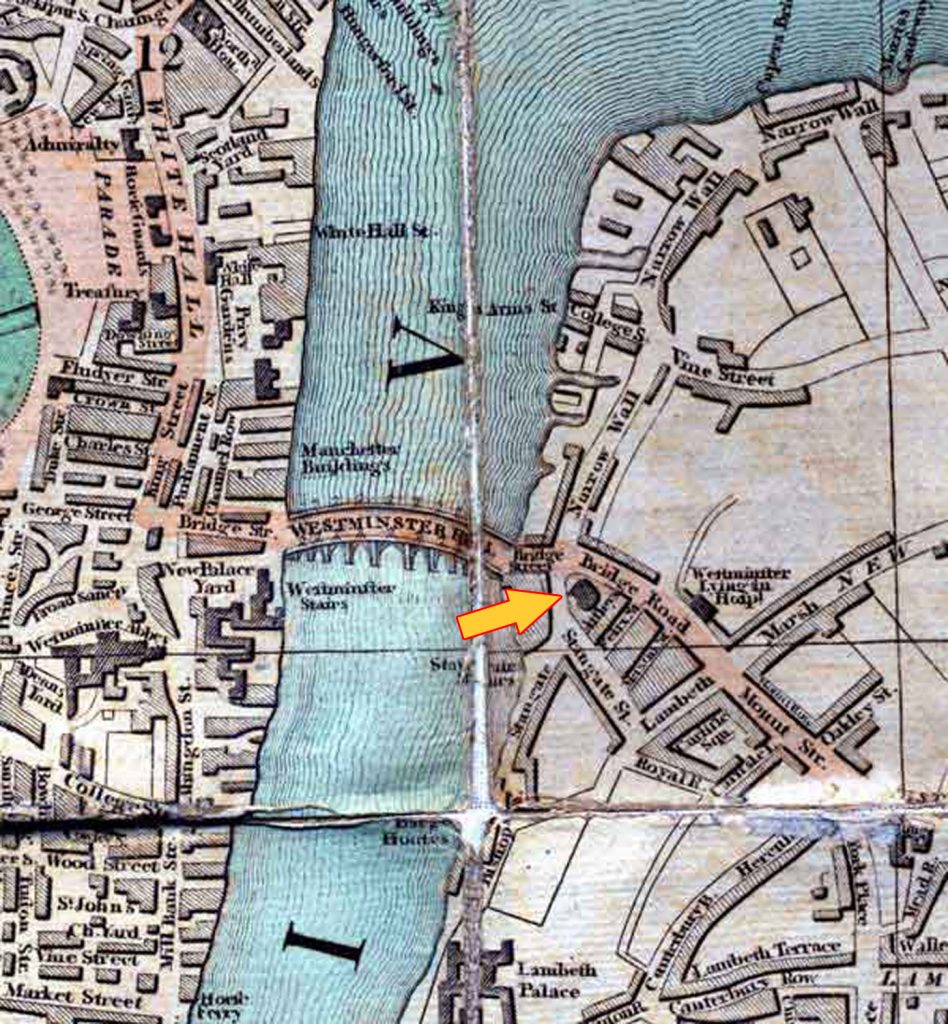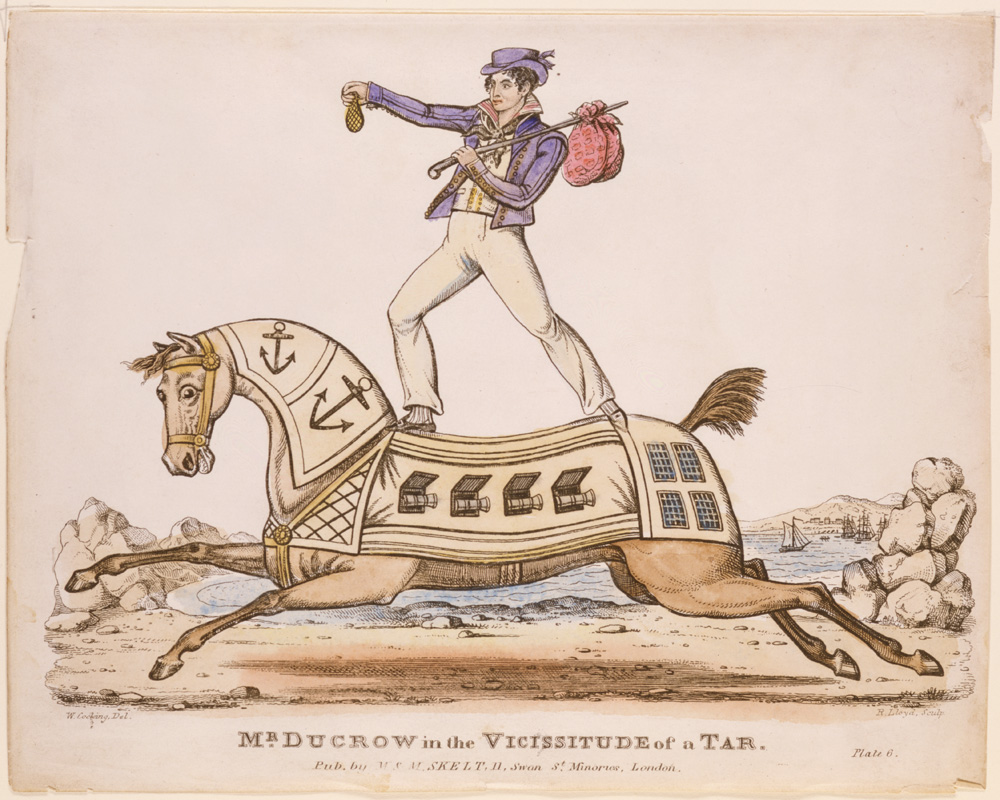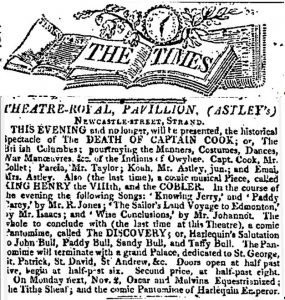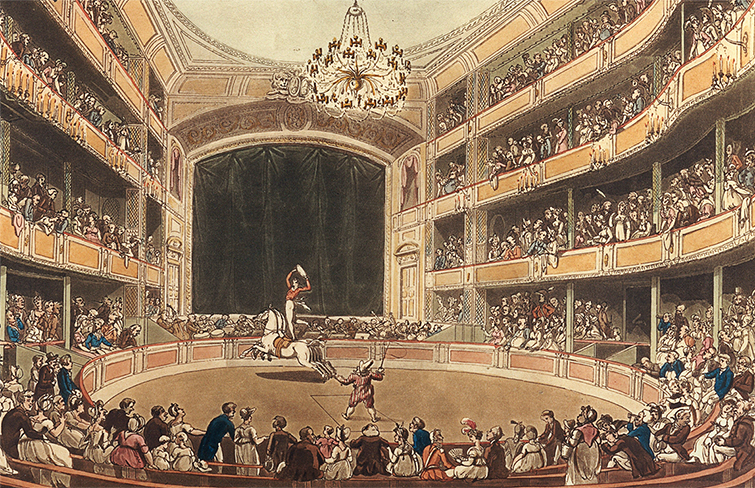The Death of Captain Cook:
a grand equestrian dramatic spectacle
The Death of Captain Cook was first presented as a ‘grand serious ballet’ in Paris in 1788, with an English adaptation in London’s Covent Garden Theatre the following year. Although it seems curious to tell Cook’s story in ballet, the concept of it being converted into an equestrian drama in the circus, seems even more bizarre. This is exactly what the flamboyant Phillip Astley offered to audiences in London, England, Dublin and Paris.
Astley is regarded as the founding father of the circus. He is credited with developing a new form of entertainment by combining equestrian and acrobatic acts, clowns, tightrope walkers, jugglers, pantomime, dancing dogs and music to create spectacular performances.
At seventeen, Philip Astley enlisted as a light horseman in His Majesty’s Royal Regiment of Light Dragoons and his natural ability as an equestrian was quickly recognised. He was given the task of training new horses for the regiment, and learnt the latest methods to improve the effectiveness of cavalry horses. He distinguished himself in battle with feats of bravery and horsemanship, and was raised to the rank of Sergeant Major. Upon leaving the regiment, his commander General Elliott presented him with the magnificent white charger Gibraltar as a token of his esteem.

Astley’s Royal Grove was built in 1770 south of the Thames near Westminster Bridge and specialised in equestrian dramas. 2
In 1768, Astley established a riding school and began to give performances on his now famous horse. This entertainment proved to be very successful and he began to consider ways to attract larger audiences. In 1770 he opened a new venue – a covered building where he could stage candle-lit performances in the evenings and through winter. This novel idea was considered so outlandish, that he arranged for “the dome-shaped roof to be painted with representations of branches and leaves of trees, and gave the new edifice the airy appellation of ‘The Royal Grove’”3 to convey an impression of the open air.
Astley’s new approach brought immediate success and he looked for more ways to develop the show:
So, with the originality of genius—for who else would ever have thought of such a thing!—he brought out a grand equestrian dramatic spectacle, entitled “The Death of Captain Cook.”4
The discoveries and death of Captain Cook had caused an extraordinary sensation in England and theatre impresarios had created the pantomime Omai, and the grand serious ballet, The Death of Captain Cook to commemorate the great explorer’s life, and to give audiences a glimpse of his travels. In January 1793, Astley took advantage of the fascination with Cook to produce his own version of The Death of Captain Cook as a grand equestrian dramatic spectacle. This remarkable piece was so successful, it formed “a very important step in the ladder by which the quondam sergeant-major rose to fame and fortune.”5

There are no illustrations of Astley’s Death of Captain Cook, but a print from a latter production gives an impression of how Cook may have appeared, mounted on a white charger performing dazzling feats in the South Seas. 6
Astley’s formula for spectacular entertainment proved to be so popular that he toured widely throughout England and continental Europe, and soon others began to copy his shows. He maintained permanent amphitheatres in London, Dublin, and Paris, and established eighteen other circuses in cities throughout Europe. Performers trained by Astley ranged around the globe to America, Australia, and Canada taking their circus skills with them.
Follow these links to read about The Death of Captain Cook in Dublin, at the Edinburgh Equestrian Circus, and in Rickett’s Circus, USA [to be added soon]

Advertisement for The Death of Captain Cook at Theatre Royal Pavillion, the Strand.
The Times. Saturday, Oct. 31, 1812.7
Over the years, Astley’s amphitheatre was destroyed by fire three times, and each time he managed to rebuild. In 1806, he opened another circus, the Olympic Pavilion in central London, on the corner of Newcastle and Wych Streets, in the Strand. The Death of Captain Cook was staged there in 1808 and 1812.
It is difficult to trace exactly where the equestrian drama of The Death of Captain Cook was performed. Circus productions tended to be ephemeral – in some places the shows were advertised in newspapers, in others with broadsides – consequently many of the records have not survived. One aspect which provides an insight into the performances is the music which was published to cater for the rapidly increasing demand for sheet music to be played in the home.
Music
The visual spectacle was always ‘heard through’ music, and popular music from the circus performances (as for the patent theatres of the day), was published for the domestic market, ensuring that some part of the experience could be relived at home.8
A key factor in the enormous popularity of the circus was the music. Audiences loved the combination of dance music, favourite songs, rousing choruses, orchestral overtures, and military marches which accompanied the fantastic displays. Some of the music from the London performances of the Death of Captain Cook was used in the Edinburgh Equestrian Circus and published in a number of collections.9
Music from Astley’s amphitheatre in Dublin was also published10, however, none of this seems to relate to The Death of Captain Cook. It is worth noting that some of the tunes from Astley’s circus did become extremely popular and entered into the mainstream culture. Astley’s Ride, Astley’s Hornpipe, and the signature tune for one of Astley’s performers, Rickett’s Hornpipe, are found in a large number of printed collections and manuscript. The Scottish convict in Tasmania, Alexander Laing included Astley’s Hornpipe in his music manuscript, as did the ship’s musician, William Litten.
The National Library of Australia holds a copy of The Celebrated circus tunes perform’d at Edinburgh this season (1790) which includes two pieces from the pantomime The Death of Captain Cook – the Duke of York’s March (2/4), and the Pursuit (6/8). These tunes are attributed to Shroeter, not Rochefort the original composer of the ballet, leading to the conclusion that they were specifically composed for the circus. This book of music is particularly interesting as one of the subscribers was Miss Eliza Campbell of Airds. Miss Campbell married Lachlan Macquarie, and as the governor’s wife, became a leading figure in early colonial society.
References
1 Astley’s Amphitheatre in 1807. Aquatint print by Augustus Pugin and Thomas Rowlandson for Rudolph Ackermann’s Microcosm of London (1807) — Dominique Jando Collection. http://www.circopedia.org/Philip_Astley
2 Map of London showing the Royal Grove. From A Picture of London for 1802 by R. Phillips. http://www.circopedia.org/Philip_Astley
3 Walford, E. (1878) ‘Lambeth: Introduction and the transpontine theatres’, in Old and New London: Volume 6 .London, 1878, pp. 383-407. British History Online http://www.british-history.ac.uk/old-new-london/vol6/pp383-407 [accessed 12 May 2020].
4 Pinkerton, W. (1862-1863) Astley’s in Once a Week, Series 1, Volume VIII. London, Bradbury & Evans https://en.wikisource.org/wiki/Once_a_Week_(magazine)/Series_1/Volume_8/Astley%27s
5 Ibid.
6 The Vicissitude of a Tar, c.1840. Victoria & Albert Museum
7 The Times. Saturday, Oct. 31, 1812, p. 3. The Times Digital Archive, https://link.gale.com/apps/doc/CS50476895/GDCS?u=bccl&sid=GDCS&xid=478d2ba2. Accessed 21 May 2020
8 Baston, K. (2018). The Celebrated Circus Tunes: Music and Musicians in an Eighteenth-Century Circus. Popular Entertainment Studies, 9 (1-2), 6-24.
9 National Library of Scotland https://digital.nls.uk/special-collections-of-printed-music/archive/102743187 . Other collections also available. See also Baston, K. (2018). The Celebrated Circus Tunes
10 National Library of Ireland (341789). New Theatre-Royal, Peter-Street : This present Thursday, the 10th of December, 1789, and every Evening, by way of Prelude, Mons. Henry, Proffesor of Natural Philosophy, Will display a Variety of Philosophical Fire-Works…: A new Musical Piece, called, The Cobbler ; Or the Lottery Ticket…: A new Musical Piece, in 3 Acts, called, The Royal Naval Review, At Plymouth ; Or Devonshire and Cornwall Loyalty.. [Dublin]. http://catalogue.nli.ie/Record/vtls000534893
Other collections also available.
11 Watlen, John (1790). The Celebrated circus tunes perform’d at Edinburgh this season : with the addition of some new reels and strathspeys / set for the piano forte or violin and bass by John Watlen. Printed for the Author. https://trove.nla.gov.au/version/264710178
Select Bibliography
Baston, K. (2018). The Celebrated Circus Tunes: Music and Musicians in an Eighteenth-Century Circus. Popular Entertainment Studies, 9 (1-2), 6-24.
Jando, D.(2018) Philip Astley, Circus Owner, Equestrian http://www.circopedia.org/Philip_Astley
Kwint, M. (1995). Astley’s amphitheatre and the early circus in England, 1768-1830. In: ProQuest Dissertations Publishing.
Pisani, M. V. (2014). Music for the Melodramatic Theatre in Nineteenth-Century London and New York. Iowa City: University of Iowa Press.
Rendell, M.(2014) Astley’s Circus — The story of an English Hussar CreateSpace Independent Publishing Platform.
Saxon, A. H. (1975). The Circus as Theatre: Astley’s and Its Actors in the Age of Romanticism. Educational Theatre Journal, 27(3), 299-312.
Walford, E. (1878) ‘Lambeth: Introduction and the transpontine theatres’, in Old and New London: Volume 6 .London, 1878, pp. 383-407. British History Online http://www.british-history.ac.uk/old-new-london/vol6/pp383-407 [accessed 12 May 2020].
Ward, S. (2018). Father of the modern circus ‘Billy Buttons’ : The life & times of Philip Astley. Great Britain: Pen & Sword History.
______________________________________________________________
This resource was created on the lands of the Gubbi Gubbi people.
We pay our respects to their elders past and present.
______________________________________________________________
Header credits:
1. Portrait of Captain Cook by Nathaniel Dance-Holland [Public domain]
2. A jig on board by Cruikshank. Courtesy of The Lewis Walpole Library, Yale University
3. View of the South Seas by John Cleveley the Younger [Public domain]
______________________________________________________________
The information on this website www.historicaldance.au may be copied for personal use only, and must be acknowledged as from this website. It may not be reproduced for publication without prior permission from Dr Heather Blasdale Clarke.


